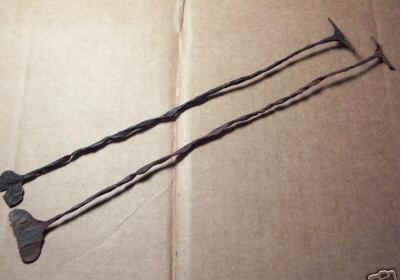
US $17.59 (euro 13,76), Feb-16-05, ebay, tocomabyt
 |
2 pieces of Kissi penny, one of the best known of African primitive
currencies. Twisted iron rod with flattened ends. Length: 24 and 22 cm, 9 1/2 and 8 3/4
inch.They were made by native blacksmiths, using iron smelted from the rich ore in the
region. Used by Loma, Kissi, Bandi, Kpelle, Mandingo, Gbandia and Gola peoples in border
regions of today's Liberia, Sierra Leone and Guinea. Used as the general purpose currency.
They were tied in bundles of twenty and used for a variety of purchases (a slave: 300
bundles, a cow: 100 bundles, a virgin bride: 200 bundles. circa 1910). Western coins were
used interchangeably with Kissies. In 1937 the District Commissioner at Voinjana,
Liberia's provisional capital, prohibited the use of Kissies in payment of the hut tax.
Demonetized in 1940's. References: Gibbs & Schulman: "Odd and Curious Money of
the World- A Complete Register" , Quiggin: "A Survey of Primitive
Money" US $17.59 (euro 13,76), Feb-16-05, ebay, tocomabyt |
ODD & CURIOUS MONEY AFRICA PRIMITIVE KISSI PENNY - COIN WITH A SOUL , 10 INCHES
Kissi PENNY (also know as Ghissi, Gitzi, Klindis & Kissi twists) are pieces of unwrought iron which served as currency in many parts of Africa. They were used for several centuries to buy wives and pigs. They were usually bundled in groups of 25 to 50 pieces. In the early 1900's you would need about 1,000 to buy a bull, 1,500 for a wife, and 5,000 to get a hard working slave. They were in common use as money from the late 1800's to the end of World War I. They were referred to as "coins with soul", and if a kissi was broken it could not circulate until repaired by a witchdoctor.